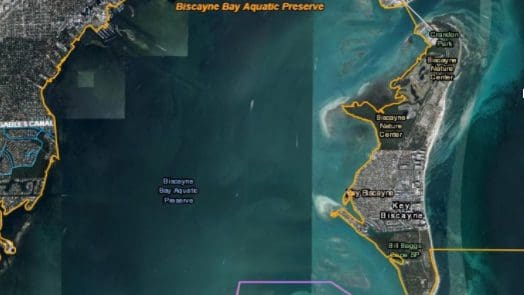In a blow for what is arguably Key Biscayne’s greatest attraction — its coast — a recent evaluation by Miami-Dade County rated much of the island’s bayside waters as either “poor” or merely “fair.”
Using six water quality parameters and two ‘habitat’ factors relating to marine life, the scorecard gives the entire west coast of Key Biscayne only a “fair” score, while further west in the bay, the water lapping the island’s mainland neighbors in Coral Gables was rated as “poor” overall.
Quality Local News Needs Your Support – Every Donation Helps
Kelly Cox, chief lawyer for advocacy group Miami Waterkeeper, said the ratings “illustrate something that scientists have been saying for years — Biscayne Bay is in decline.”
Data for the scorecard comes from last year’s measurements taken by multiple monitoring stations throughout the bay. The aim is to monitor the delicate balance of nutrients –such as nitrogen and phosphorus– as well as bacteria that contribute to a healthy marine environment.
Key Biscayne’s worst score (1 out of a possible 5, rated “poor”) was for the overabundance of chlorophyll-a, a pigment found in plants and algae. Its presence can be an indicator of disruptive “algae bloom” events, several of which have dogged the bay in recent years.
Excess chlorophyll-a suggests lots of phytoplankton and microscopic algae in the water, which usually indicates excess nutrients. The algal ‘bloom’ starts to block sunlight from reaching other plants such as seagrass, which begin to die off. At the same time, bacteria breaking down the algae uses up oxygen in the water, meaning large swathes of water can no longer sustain some fish and marine organisms — as evidenced during several so-called “fish kills” last year.
For Dr. Roland Samimy, who heads up the Village of Key Biscayne’s resiliency efforts, the results were not unexpected.
“Scorecards such as this are great for raising public awareness,” he said. While he does intend to drill further into the data used to understand its parameters, he said that “when it comes to nutrient load, we know that less is more.”
In a presentation introducing the scorecard Lee Hefty, assistant director at Miami-Dade County’s Division of Environmental Resources Management (DERM), said human activity has greatly affected the water quality of Biscayne Bay through the contamination of stormwater via pet waste, fertilizers, and landscape. But climate change is also to blame, as leaking sewer or septic systems in low-lying areas become sources of contamination when combined with sea-level rise. Warmer water –an obvious occurrence during the summer, commencing June 21– is also a well-documented symptom of global climate change. The hotter the water, the fewer dissolved gasses (such as oxygen) it can hold, further endangering marine life.
Cox’s organisation advocates for “rapid, cross-sectional action to address land based sources of pollution.” Gov. Ron DeSantis signed a bipartisan bill that creates a “Biscayne Bay Commission” at Bill Baggs Cape Florida State Park Thursday.
At county level, the Miami-Dade Commission adopted a resolution allowing Mayor Daniella Levine Cava to apply for state and federal grants of up to $1 million for environmental issues including those affecting the bay.
More locally, Dr. Samimy said projects underway within the Village –such as the connection of septic tanks to sewer mains as well as the upgrading of stormwater drains, with the addition of water quality treatment technology– are part of his work in this area.
“I am driving this because I understand nutrient issues,” he said.
—
NOTE: Rumya Sundaram co-authored this article


